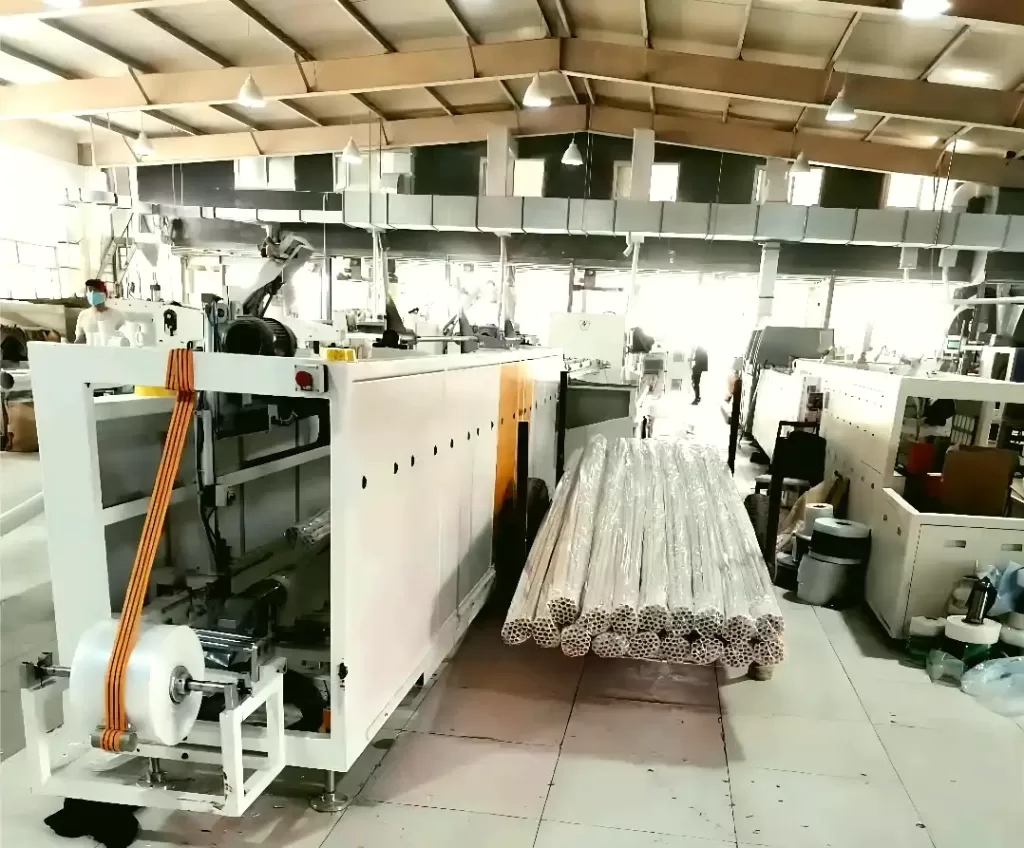Streamlining End-of-Line Operations: A Guide to Automatic Roll Packing and Shrink Wrapping Systems
Handling and packaging large, unwieldy rolls of material – whether carpet, paper, film, or textiles – presents significant challenges in many manufacturing and distribution environments. Manual processes can be slow, labor-intensive, inconsistent, and risk product damage or worker injury. Implementing automated solutions like automatic roll packing machines and shrink wrapping systems can dramatically improve efficiency, product protection, and safety at the end of your production line.
This guide explores the functionality and benefits of these automated packaging systems, focusing on their application for various rolled goods, including carpets.

The Need for Automation in Roll Packaging
Manually wrapping and securing heavy or bulky rolls is often a bottleneck. It requires significant physical effort, leading to potential ergonomic issues. Furthermore, achieving consistent wrap tension and coverage manually is difficult, potentially compromising load stability and protection during transit and storage. Automated systems address these issues directly.
Understanding Automatic Roll Packing Machines
An automatic roll packing machine is designed to efficiently wrap and secure rolls of material using packaging films like stretch wrap or shrink film. While designs vary, the core function involves mechanically applying the film around the roll's circumference and often across its ends.
Common Operational Steps:
- Infeed: Rolls are typically fed onto the machine via a conveyor system, often directly from the production line.
- Positioning: The machine positions the roll correctly for wrapping. Sensors detect the roll's dimensions (diameter and length) to ensure proper film application.
- Wrapping: A dispensing mechanism applies the chosen packaging film (e.g., stretch film) around the roll as it rotates or as the film carriage moves around it. For full enclosure, systems might apply film across the ends or utilize bagging techniques.
- Sealing/Cutting: Once wrapping is complete, the film is automatically cut and secured (e.g., heat-sealed or wiped down).
- Outfeed: The securely packed roll is discharged from the machine, typically onto another conveyor for transport to warehousing or shipping.
Specialized Solutions: Carpet Packing and Shrink Wrapping
Carpets present unique packaging challenges due to their bulk, weight, and the need to protect the pile. Automated systems are specifically adapted for these requirements.
Carpet Roll Packing:
Similar to general roll packers, these machines securely wrap the body of the carpet roll. Stretch wrapping is common for securing the roll tightly.
Carpet Shrink Wrapping / Shrink Tunnel:
After initial packing or bagging, rolls often pass through a carpet shrinking machine or a heat shrink tunnel.
- Process: The loosely wrapped roll (often in shrink film) enters a heated chamber.
- Mechanism: Controlled hot air circulation causes the shrink film to conform tightly to the shape of the carpet roll, creating a durable, weather-resistant, and tamper-evident seal.
- Result: This process provides excellent protection against moisture, dirt, and abrasion during handling and storage.

online pipe bundling ang bagging machine1 Versatility: Beyond Carpets
While carpet packaging is a key application, automatic roll wrapping technology is highly versatile. Similar systems are employed for:
- Paper Rolls: Newsprint, kraft paper, coated papers.
- Film Rolls: Plastic films, laminates.
- Textiles & Nonwovens: Fabric rolls, insulation materials.
- Roofing Materials: Felt rolls, membranes.
The specific machine configuration, film type, and wrapping parameters are adjusted based on the product's characteristics and protection requirements.
Key Benefits of Automated Roll Packaging Systems
Integrating automatic roll packing and shrinking offers substantial advantages:
- Increased Throughput & Efficiency: Automated systems operate significantly faster than manual methods, reducing bottlenecks and aligning packaging speed with production output. They enable seamless integration into fully automated production lines.
- Improved Product Protection: Consistent, tight wrapping shields products from environmental factors (dust, moisture), handling abrasion, and transit damage, reducing costly returns and waste. Shrink wrapping provides an enhanced barrier.
- Enhanced Load Stability: Uniform film application and tension ensure rolls are stable for stacking, storage, and transportation, minimizing the risk of shifting or collapse.
- Reduced Labor Costs & Improved Safety: Automation minimizes the need for manual handling of heavy, awkward rolls, reducing direct labor costs and significantly improving workplace ergonomics and safety by lowering the risk of strains and injuries.
- Optimized Material Usage: Machines apply film consistently and efficiently, often using less material compared to manual wrapping while achieving better results.
- Professional Appearance: Automated wrapping provides a consistent, clean, and professional look for finished goods.
Implementation Considerations
When considering automated roll packaging, factors include:
- Roll Size Range: Ensure the machine can handle your minimum and maximum roll diameters and lengths.
- Throughput Requirements: Match machine speed to your production needs.
- Integration: Plan how the system will connect with upstream and downstream equipment (conveyors, labeling systems).
- Space: Allocate sufficient floor space for the machine and associated conveyors.
- Film Type: Determine the appropriate packaging film (stretch, shrink) based on protection needs and cost.
- Customization: Discuss specific needs like end-wrapping, labeling integration, or special handling requirements with suppliers.

automatic pipe bagging machine for pvc and ppr Conclusion
For manufacturers dealing with carpets, paper, film, textiles, or other rolled goods, investing in automatic roll packing and shrink wrapping systems is a strategic move towards greater operational efficiency and product integrity. These machines deliver significant improvements in speed, consistency, product protection, and worker safety compared to manual methods. By automating this critical end-of-line process, businesses can reduce costs, enhance productivity, and ensure their products reach customers in optimal condition.

